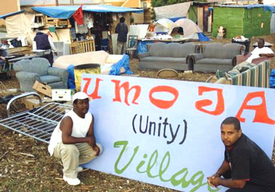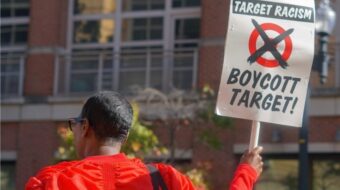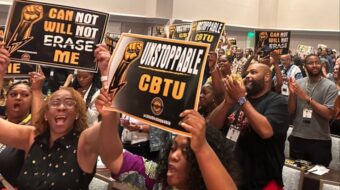
MIAMI, Fla. — “We are housing for the people, by the people,” proclaims a sign outside the kitchen at Umoja Village in Liberty City, Miami. What is Umoja Village and how did it come to be in the historic heart of the African American quarter here?
Umoja Village is a vibrant, growing community, a shantytown on a vacant public lot in Liberty City near 62nd Street and NW 17th Avenue. Begun on Oct. 23, the physical set consists of a kitchen; 12 two-person shanties built out of wood pallets, with plywood roofs, cardboard siding, and gloriously colorful paint; sofas arrayed around an area rug laid on mulch; young vegetable gardens; and an organic toilet.
On any given night, about 35 homeless people, mostly men, stay here, with a couple of activist volunteers. The village is a true grassroots project of the Center for Pan-African Development and the local community, with help from other local activist groups, including Power U, student groups, anarchist collectives and peace and justice organizations.
Umoja Village came into being as a direct response to Miami’s low-income housing crisis. In 1997, activists complained to city authorities about the horrific conditions of area apartments, demanding enforcement of city codes. Their complaints ignored, activists went to the media.
When these conditions, including unsafe, crumbling stairs and rat holes in the walls, were aired on television, city officials sat up and paid attention. But instead of enforcing codes, they ruled the building uninhabitable and tore it down. Sixty-two families were rendered homeless overnight.
The slumlord did real well, though, when the city paid $900,000 for the property.
Promised affordable replacement housing has yet to appear. All told, 483 units have been destroyed this way. Between the Miami-Dade County Housing Authority and the Liberty City Trust, nearly $10 million has been spent, with virtually nothing to show for it. In four years, only eight homes have been rebuilt.
According to Max Rameau of the Center for Pan-African Development, “Obviously the government has no interest in helping poor Black people, so we have to do it ourselves. We’re doing it by taking control of the land.”
According to Rameau, one of the unique features of Umoja Village is that the residents themselves, people who a few short weeks ago were sleeping under bridges, have not only done much of the building, but are maintaining the community. They keep the property clean, run the kitchen, do the gardening and handle the composting for the natural toilet. The goal is to make the shantytown self-sufficient, with residents ready to go it alone.
When Ronnie Holmes learned of this place, where he could sleep, eat and change his clothes, he jumped at the chance. He was asked to help build a shanty. He built that, then another, and another, and he is still at it.
When Holmes’ son and his caretaker learned that he was there, they came to visit him. His son’s visit, after a four-year separation, gave him a tremendous lift.
Referring to his fellow residents, Holmes said he is convinced that “some of the greatest minds you want to get are here. If these folks get stable enough to take a bath and get a change of clothes, there’s no telling what they could do.”
Besides providing shelter for its residents, Umoja Village has put a spotlight on the nation’s housing crisis and its treatment of the poor. The poor suffer tremendously from the lack of decent housing, a healthy diet, medical care and quality education for their children. Families are separated. Lives are cut short.
In truth, everyone misses out when the talents, skills and creativity of so many people are lost to the larger community.
Holmes believes that at the very least, this project will lead the community to recognize the problem and work toward solving it. His highest hope is that the project will result in housing for everyone who wants it.
As Ronnie Holmes said, “A person should be able to have housing, I don’t care how poor you are, or rich.”
For more information, visit .









